Technical writing is an activity that you can’t do on autopilot—if you want to provide readers with a great user experience, you need to write with focus, dedication, and consistency.
However, maintaining productivity can become challenging, especially if you’re dealing with demanding technical topics.
If you’d like to avoid wasting time and energy on unproductive work, you might want to consider the tips we’ll lay out in this article.
Don’t worry, you don’t need the latest expensive setup—we’ll teach you how to tweak your writing processes to work in your favor and keep you productive for longer stretches of time.
Create a Writing Schedule
We’ll start with the most straightforward way you can boost your productivity, and that’s creating a schedule and sticking to it.
Unlike free-form writing, technical writing requires focus and lots of preparatory steps—you can’t just sit down and start pouring down your thoughts into a Google doc.
That’s why some writers postpone working, killing productivity in the process.
According to technical writer Finnegan Rigby, meetings, SME interviews, and creating visual elements are just some of the activities in a tech writer’s day, and that’s without factoring writing in.
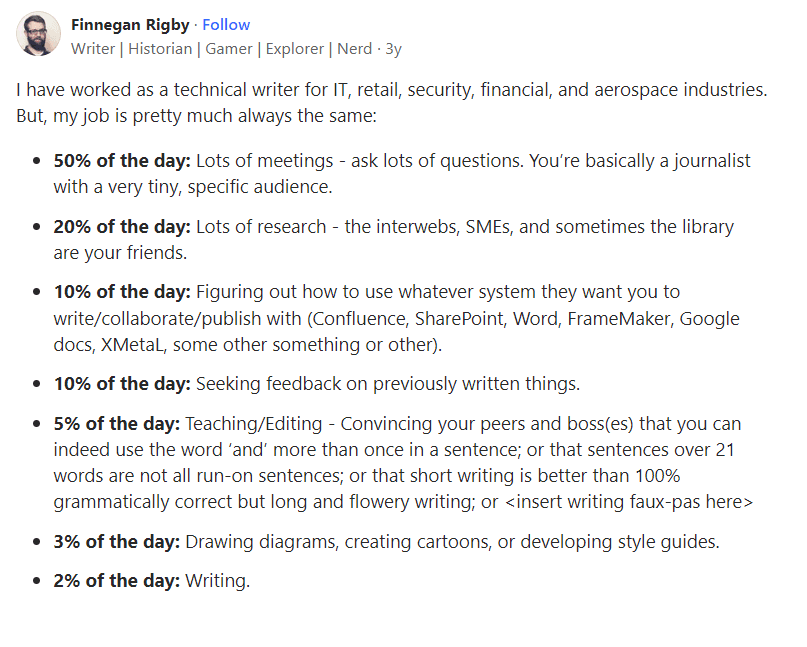
Source: Quora
You can see how the sheer amount of preparatory steps could make writing difficult to get to.
However, allocating a time window for each of these would provide you with structure. For instance, you could decide to start each morning by editing what you’ve written previously.
Having an actionable item on your agenda would then give you momentum so that you can continue with writing or other related tasks, depending on what you’ve put in your schedule.
Such an approach is especially beneficial if you don’t have strict deadlines to force you to write. In such cases, creating a writing schedule acts like a self-imposed deadline.
In addition to scheduling pre-writing and post-writing activities, your schedule could also segment the writing process.
For instance, the writing schedule designed by tech writer Colin Dunbar defines exactly when the author will create the draft for each chapter.
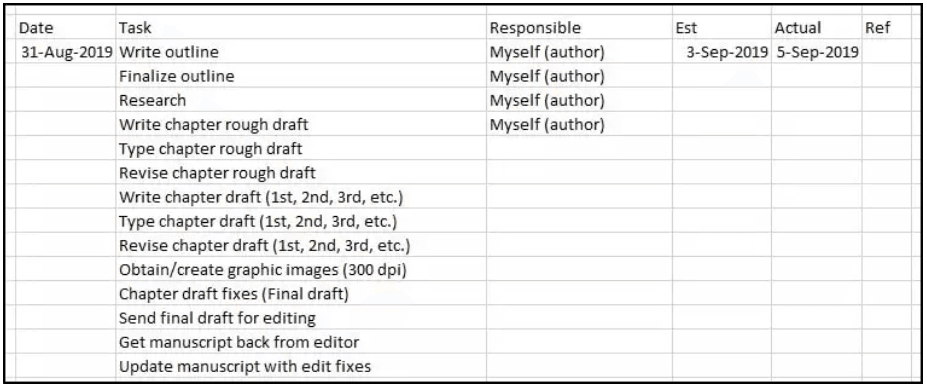
Source: Self-Publishing
Regardless of the type of items you include in your writing schedule, creating one and sticking to the time limits it prescribes will help you keep your work on track.
No more wasting time and concentration on choosing what task to take and when to do it—schedules are there to guide your writing process.
There are hundreds of planner apps you could use to create a writing schedule and get an overview of work in progress.
Still, bear in mind that almost half of all workers believe that using too many apps lowers their productivity.
So if you think that using an app would make you spend more time planning than writing, you could opt for creating a simple table in one of the tools you already use for writing.
That would allow you to reap all the benefits of having a schedule without investing additional time into managing new software.
Set a Daily Productivity Goal
If you want to maintain motivation and productivity, you have to have a goal to work towards.
Meeting a daily writing goal, such as a targeted word count or the number of sections completed can make you feel accomplished.
A daily word-count goal is a target that many writers use to keep themselves motivated.
However, the metric isn’t fully applicable to technical writing, considering that this discipline values using fewer words.
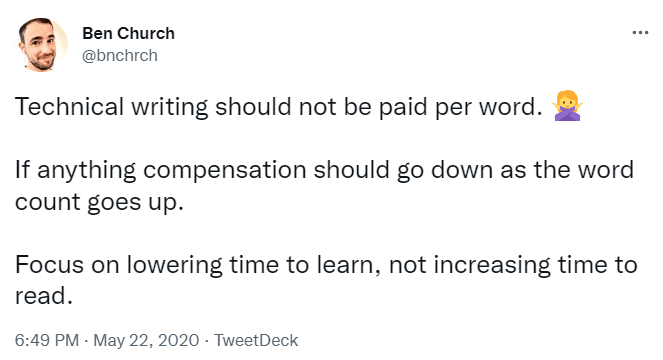
Source: Twitter
So, if you want a tool to keep yourself accountable, you could find an alternative goal.
Depending on the type of document you’re working on, you could break down the workload into smaller sections.
If you were writing, say, a user guide that contains FAQs or a troubleshooting guide, you could determine the number of questions to cover every day.
For instance, the FAQ section of the customer engagement platform Vizury contains a series of concise answers.
Writers dealing with a similar format could track how long it takes to compose one entry and calculate the hourly quota.
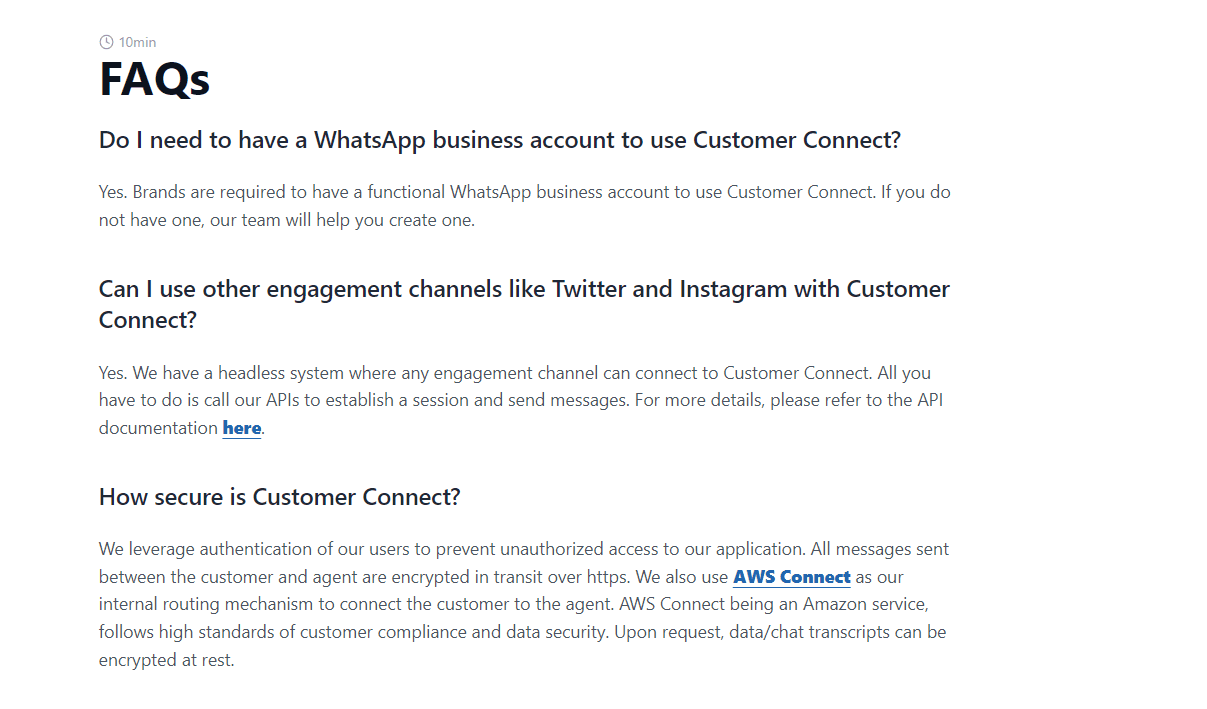
Source: Vizury
For longer or more complex pieces, you’ll need to reduce the number of sections you plan to write in a day to keep things realistic.
Either way, having a goal to reach creates positive pressure, and the sense of accomplishment rises with each finished task.
You could also take a different approach to goal-setting and aim for a certain amount of time to spend writing every day.
That’s a common practice in academic writing, but there’s no reason why you shouldn’t apply it to technical writing as well.
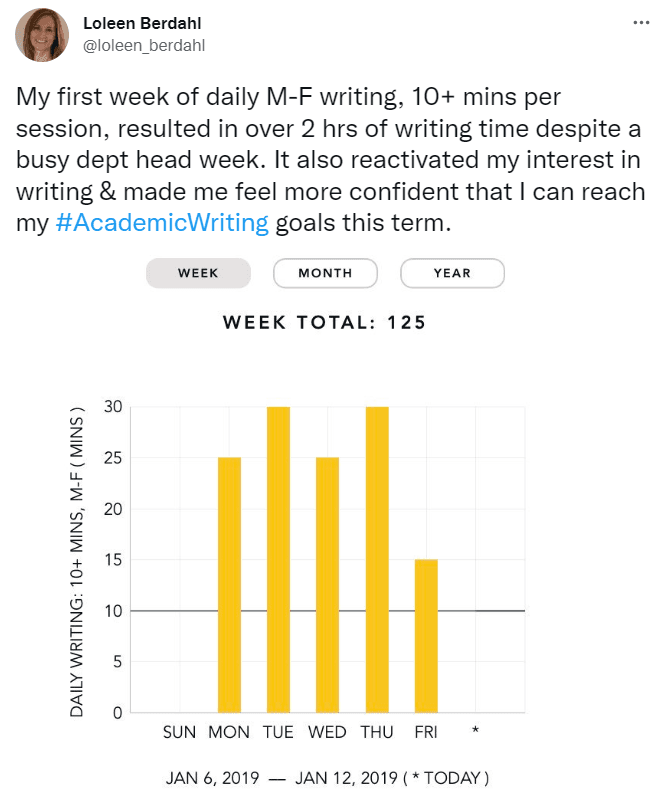
Source: Twitter
An additional benefit of tracking the writing time is that it helps you determine the weekly total. You can use the data to better estimate future projects and set precise deadlines.
All in all, the exact type of writing goal you set isn’t the most important factor of this productivity strategy.
Instead, what matters the most is that you set a benchmark to strive towards and direct your efforts to meeting it on a daily or weekly basis.
Avoid Multitasking
Productivity can be difficult to achieve when your brain has too many proverbial tabs open.
You can preserve energy and get more things done by avoiding multitasking and only focusing on the task at hand.
Would you say you are good at multitasking?
If not, you’re far from alone—research shows that a whopping 97.5% of people don’t achieve good results when their attention is divided.
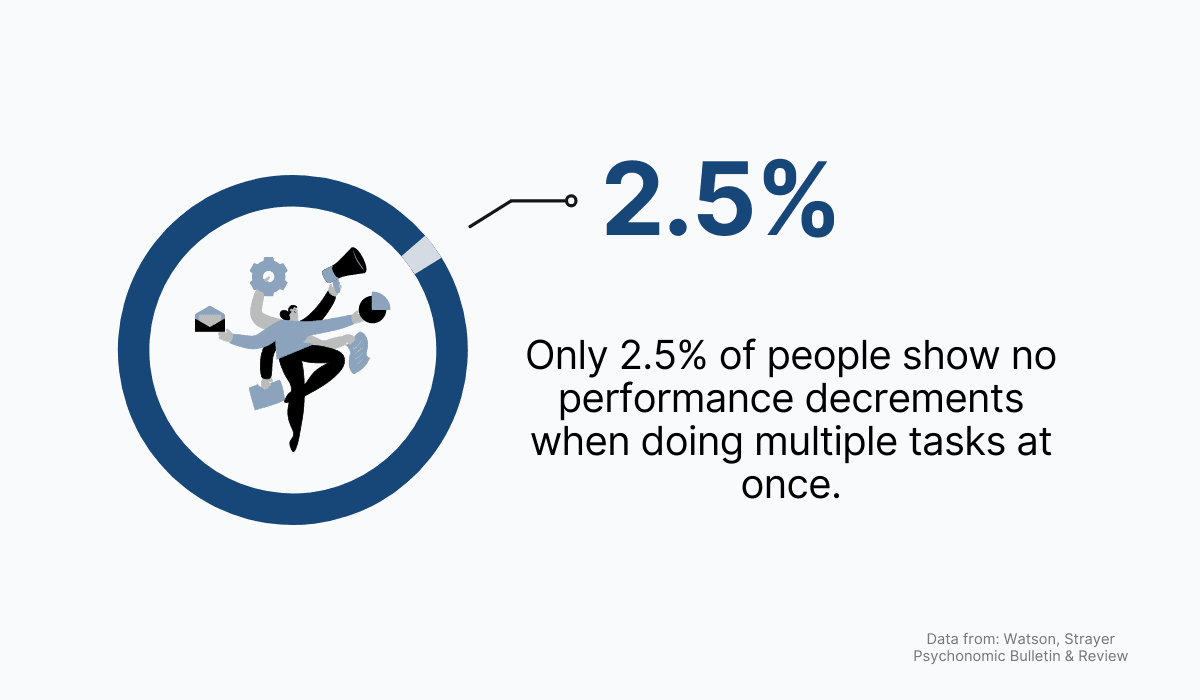
Source: Archbee
Luckily, multitasking isn’t a skill you need in order to be a successful technical writer.
If anything, good tech writers know that they can increase their productivity and create better content by focusing on one job at a time.
If you try to tackle research, drafting, and creating visual elements all at once, you’ll be forced to give each task only a portion of your attention.
Moreover, constant context switching is a major time suck, meaning that multitasking won’t only harm the quality of your work—it will make you slower, too.
So, what can you do to actively avoid the perils of multitasking?
According to the technical writing expert Tom Johnson, you have to learn how to say “no” not only to yourself but also to clients, product owners, and managers who ask for too much.
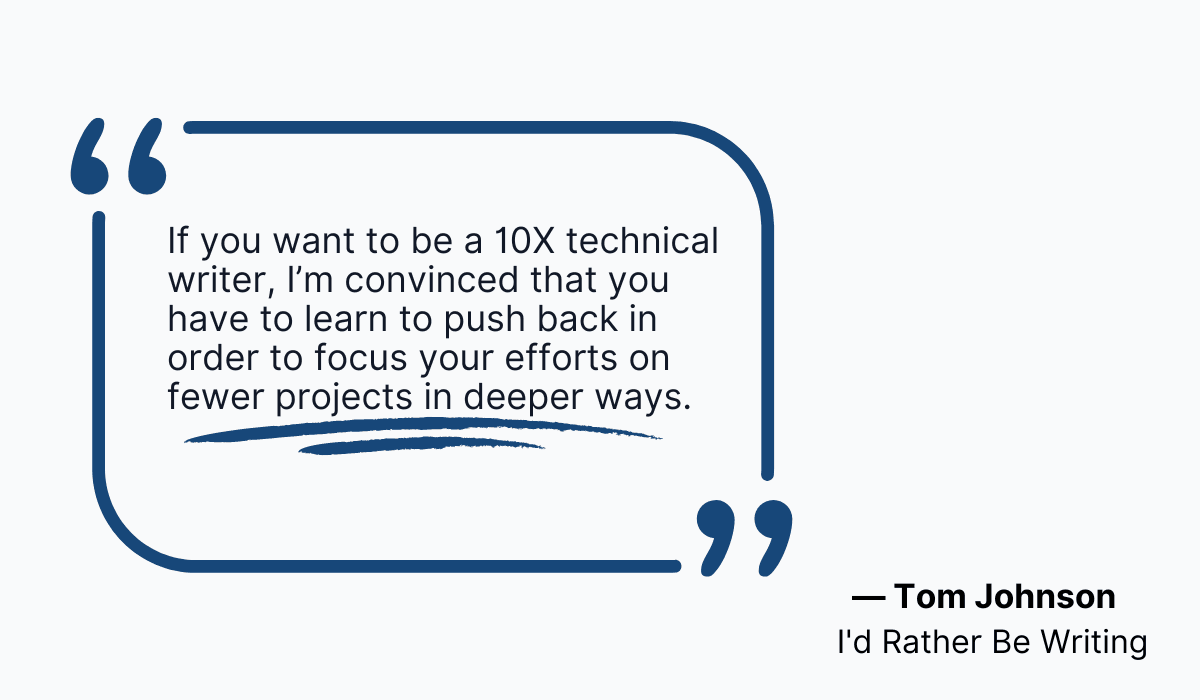
Source: Archbee
While creating a writing schedule can prevent you from doing several tasks at the same time, you’ll need a different approach when it comes to dealing with other people who want you to juggle several projects simultaneously.
Rather than outright pushing back, Johnson suggests explaining how the increased scope of work would negatively impact the quality of your writing.
That will help them realize that your work will be more effective when you’re focused on only one task at a time.
To sum up, multitasking can lead to spreading yourself too thin, and before you know it, your productivity and results will suffer.
By sticking to your project and writing schedule, you’ll be able to retain the writing quality and stay productive longer.
Create an Outline First
Imagine the following scenario. You’ve allocated the following hour for writing, muted Slack, and are now ready to start writing the document.
However, you don’t know where to start, and the blank screen staring at you isn’t doing your productivity any favors.
That’s correct—a part of decreased productivity stems from not knowing what exactly to write.
But if you create an outline at the beginning of the process, you’ll have a defined starting point, together with clear directions you can follow as the writing progresses.
If you’ve established the outline, that means you’ve already made decisions about content structure, and you now have to fill in the text.
Some authors even joke that outlines make writing the easy part.
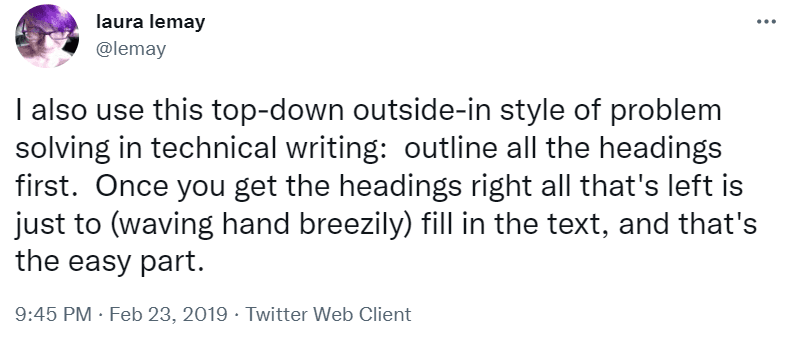
Source: Twitter
It’s worth noting that your first outline doesn’t have to be the final one.
This Reddit thread where tech writers share their work processes reveals that most authors tweak their outlines as they create tech content.
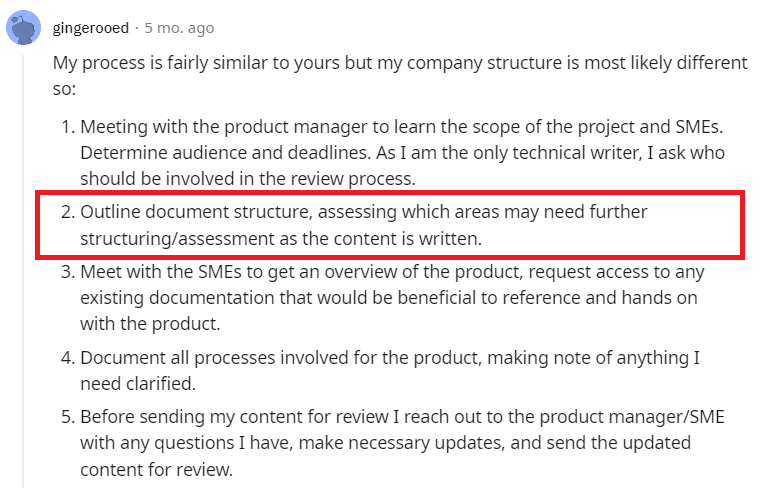
Source: Reddit
Still, it’s much more productive to start writing and change the structure if needed than to put off writing because you don’t know where to begin.
Another way how outlines contribute to productivity is by forcing you to stay on topic.
By following a prearranged content structure, you’re less likely to write about irrelevant parts of the product you’re describing.
For instance, if the outline lists the installation procedure, you won’t start writing a section about the product’s benefits that you’d later have to delete, resulting in time loss.
With that said, let’s see what an outline could look like.
The following image shows Google’s outline for a fictitious algorithm, which could find its place among other pieces of software documentation.
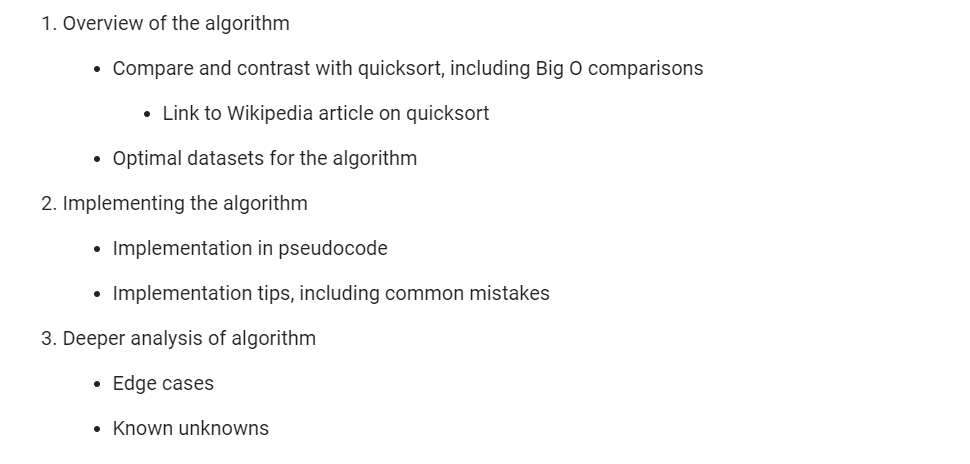
Source: Google Developers
As you can see, the outline doesn’t go into too much detail, leaving the writer the freedom to build content as they deem the most suitable.
However, it contains guidelines that are specific enough to give you the foundation to start writing and prevent you from going off-topic, and that’s what outlines are all about.
Reward Yourself for Good Work
If you’re struggling with productivity, you may need an occasional reward to keep you going.
Let’s face it: technical writing is a utilitarian field of work.
People rarely reach for tech documents unless they need help, so it’s not surprising that many tech writers take pride in creating helpful content.
In fact, the rewarding feeling you get when your docs help somebody solve a problem was among the most frequently cited pros in an online discussion about best and worst elements of being a tech writer.

Source: Reddit
However, months can pass from when you start writing until your documents receive good feedback.
So, if you can’t rely on external rewards, why wouldn’t you reward yourself for good work?
As you may recall, we suggest breaking down work into smaller chunks and working your way through them by following a writing schedule.
If you implemented that approach to tech writing, you could use the completion of each task as a time for a small celebration.
Finished formatting a table? Great, now take a break from the screen and get yourself a fresh cup of coffee or do a five-minute office-friendly yoga flow.
Immediate rewards like these have been found to increase intrinsic motivation, which is another element that plays a part in writing productivity.
In case you prefer automating as much of your life as you can, you could try using apps to direct your rewards.
For instance, Habitica is a productivity app that you can use to track your tasks and rewards.
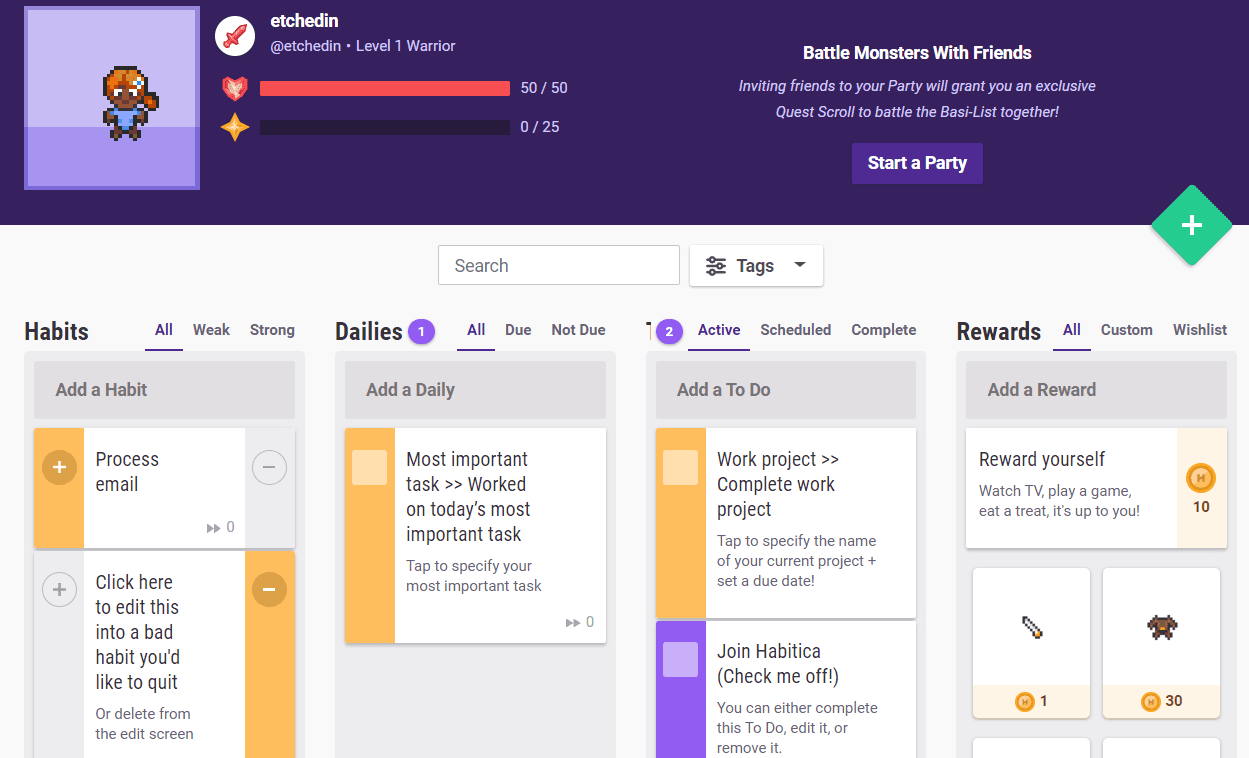
Source: Habitica
This app lets you gamify your accomplishments by collecting virtual rewards, but it also encourages you to translate the rewards into real life.
After you complete a task, the app suggests watching a bit of TV, eating a treat, or doing other activities you’ve entered as potential rewards.
So, regardless of the nature of your prize, a reward for good work will keep you motivated.
If you know there’s something fun waiting for you after you complete the section, you’ll feel less inclined to drag the writing process on.
Keep Your Workspace Organized
Lastly, you shouldn’t forget about the effect that the work environment has on productivity. By keeping your workspace organized, you’ll minimize the clutter that distracts you from work.
There are two ways you can keep your workspace tidy. The first one is literal—we’re talking about sprucing up your desk.
According to a survey conducted on more than two thousand office workers, forty percent of people become less productive when working in an untidy workspace.
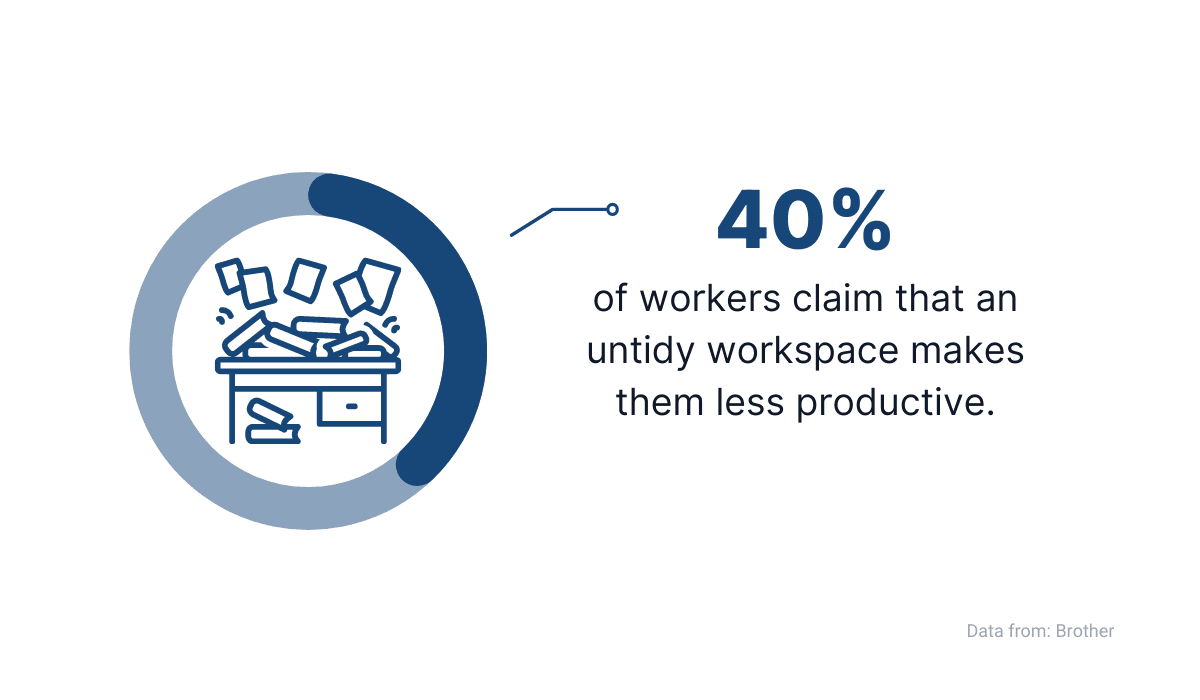
Source: Archbee
When it comes to desks specifically, the survey shows that two in five workers admit that a messy desk negatively affects their performance.
So, if you’re the type of person that could easily get distracted by reading the ingredients list of a hand sanitizer just because there’s a bottle in front of you, it might be wise to keep your desk free from everything but the tools and resources you need for work.
However, most of the tools that technical writers use aren’t physical tools, which leads us to the second way of keeping the workspace tidy.
If you want to retain a productive atmosphere, you also need to keep your desktop and browser tabs clean.
When there’s a Twitter tab open next to the documentation tool you’re using, it’s hard to resist going for a “quick” scroll down the timeline, finding yourself in a rabbit hole thirty minutes later.
That’s why screen hygiene is a must for productivity.
And if you can’t trust yourself with organizing your tabs, there are tools you can use to keep your focus in check, such as Dayboard.
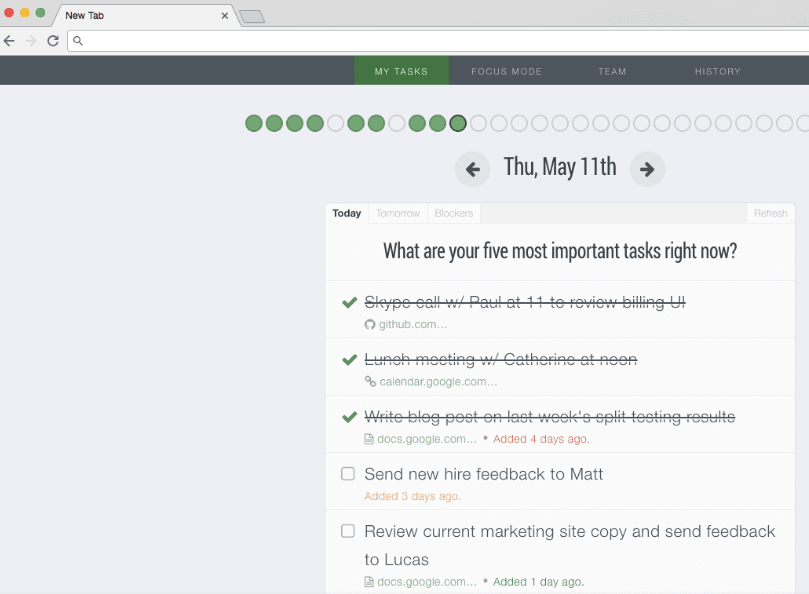
Source: Dayboard
Dayboard can be used as a regular website blocker. However, if you pair it with your to-do list, it can also tell you what you should work on next, subtly motivating you to go back to work.
Once you get your desk and your desktop under control, you’ll provide yourself with an environment conducive to productive writing.
Conclusion
Writing productivity may be elusive, but it isn’t unachievable.
Although the tips we’ve seen may seem too straightforward to work, you shouldn’t underestimate their effect.
You’d be surprised at how something simple like creating an outline can help with later stages of writing.
So, why not give these tips a try?
Frequently Asked Questions
Try these field-tested habits:
- Build a simple writing schedule that time-boxes research, SME interviews, drafting, and editing. Protect those blocks like meetings.
- Set daily goals that fit technical writing: sections completed, FAQs answered, tickets closed, or focused minutes written (not just word count).
- Single-task to avoid context switching. Do research-only blocks, then draft-only, then visuals-only.
- Outline first so you always know the next step and avoid rabbit holes.
- Reward progress (small breaks, a walk, a coffee) to keep motivation high.
- Keep your workspace tidy—both desk and desktop—to reduce friction and distractions.
- Use one planning method (a single app or a simple table in your doc tool) so you spend time writing, not managing tools.
Start with one or two habits this week, then layer in more as they stick.
